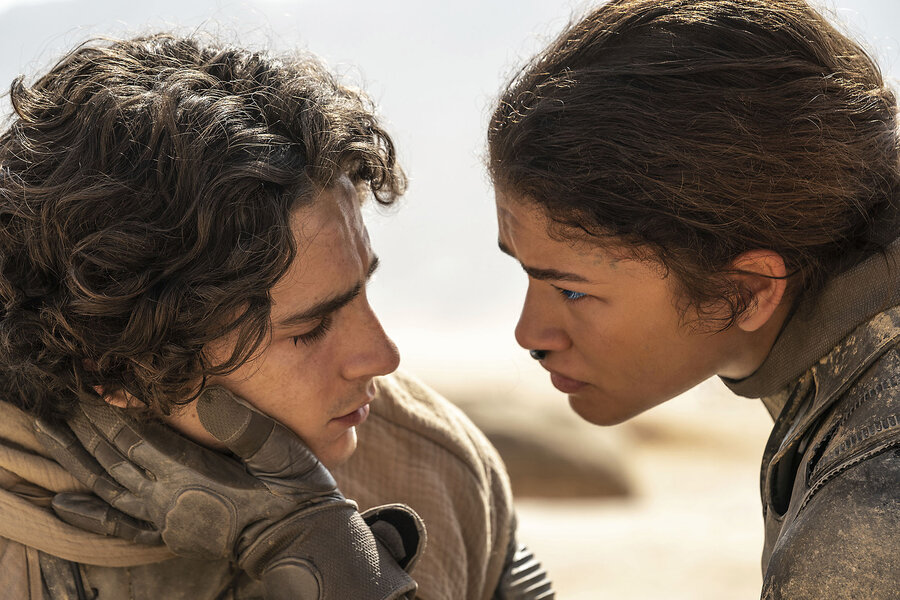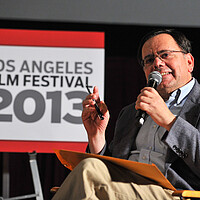‘Dune: Part Two’: Sandworms, slick villains, and a would-be savior
Loading...
Denis Villeneuve’s “Dune: Part Two” arrives almost 2 1/2 years after its predecessor came out in the thick of the pandemic. Although “Dune” was simultaneously available for viewing online, the opportunity for many to witness an intergalactic epic on the big screen – or anything on the big screen – was still something of a rarity. I found the movie middling, but the long-awaited bigness of the theatrical experience may have contributed to its popular success.
“Dune: Part Two” picks up where “Dune” left off. The visuals are still immense, but this time around, the film must stand on its own, without the benefit of pandemic-era bonus points. How does it compare?
It’s still big, that’s for sure. With the possible exception of “Lawrence of Arabia,” I’ve never seen so much sand in one movie. (Of course, the sand in David Lean’s film wasn’t CGI.) I’ve also rarely seen a movie packed with so much plot. Keeping track of the storylines derived from Frank Herbert’s eco-visionary 1965 sci-fi tome is a full-time job. That’s one reason the material had long been deemed unfilmable. Several directors before Villeneuve tried anyway: There was David Lynch’s misbegotten 1985 fiasco and a forgettable 2000 TV miniseries. Alejandro Jodorowsky tried for over a decade to finance a multipart version that was supposed to star Salvador Dalí and Orson Welles!
Why We Wrote This
“Dune: Part Two” arrives almost 2 1/2 years after the first installment. With the possible exception of “Lawrence of Arabia,” film critic Peter Rainer writes, he’s never seen so much sand in one movie.
Villeneuve’s “Dune,” which takes place in the year 10191, covered about half of the novel. The new film, co-written by Jon Spaihts, still doesn’t make it all the way through. We pick up with Paul Atreides (Timothée Chalamet) on the desert planet Arrakis, where the oppressed, nomadic Fremen are at war with the brutal Harkonnen. Besides grunting a lot, the Harkonnen also control the prized spice substance that can propel a person through space and time.
The older generation of Fremen, led by tribal leader Stilgar (an amusing Javier Bardem), believes Paul is the much-prophesied “chosen one” who will deliver them to a green paradise. (Arrakis is virtually waterless.) The skeptical younger generation, personified by Chani (Zendaya), thinks Paul is just ... Paul.
Paul himself is not so sure who or what he is, but he earns the respect of the Fremen by acing all their required tests, including an excitingly filmed high-speed ride atop a giant sandworm. If nothing else, Chani appreciates Paul’s desire to learn the ways of the Fremen. He doesn’t act like a messiah, at least not around her. A sort of love story develops involving a few chaste kisses. The unsightly nasal tubes worn by the Fremen actually look good on them – it’s an intergalactic fashion statement.
There is quite a bit more to the plot, but suffice to say, it all boils down to a mythic struggle powered by prophecy. Along the way, all sorts of familiar faces pop up. Some are repeaters from “Dune,” such as Rebecca Ferguson as Paul’s creepy mom, Lady Jessica, or Stellan Skarsgård’s bloated Baron Harkonnen. Others, such as Christopher Walken’s Padishah Emperor, are new. I welcome Walken any time, in any galaxy. He’s naturally otherworldly.
The best addition is Austin Butler as the baron’s bald-pated, hypervicious nephew. It’s official: Butler no longer looks or sounds like Elvis Presley. Villeneuve is adept at staging grand-scale battles, but the movie’s best set piece is the climactic tooth-and-nail face-off between Paul and this grinning gargoyle.
Like the first installment, “Dune: Part Two” ends abruptly, with much more story to tell. And once again, Chalamet doesn’t quite seem up to the task of portraying a rebel-rousing savior. Perhaps if they keep making these movies, he will finally grow into the role. Zendaya’s gutsy Chani, on the other hand, seems fully formed right now. If there is to be a “Part Three,” Villeneuve should depart from Herbert and make her the savior. Maybe Chani can’t save the galaxy, but she just might carry the franchise.
Peter Rainer is the Monitor’s film critic. “Dune: Part Two” is rated PG-13 for sequences of strong violence, some suggestive material, and brief strong language.








